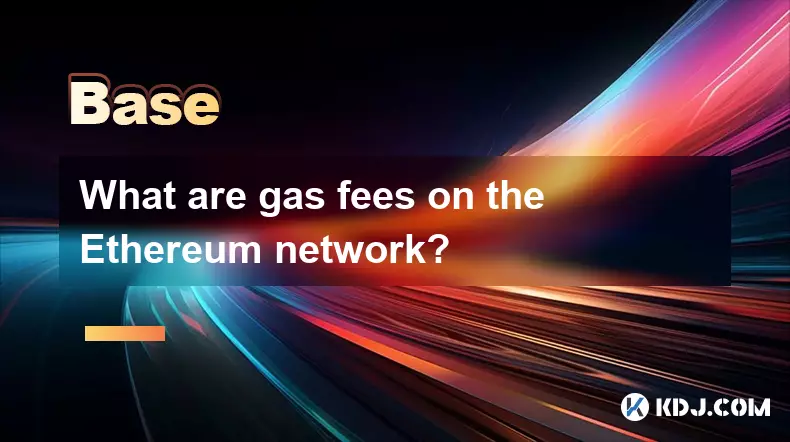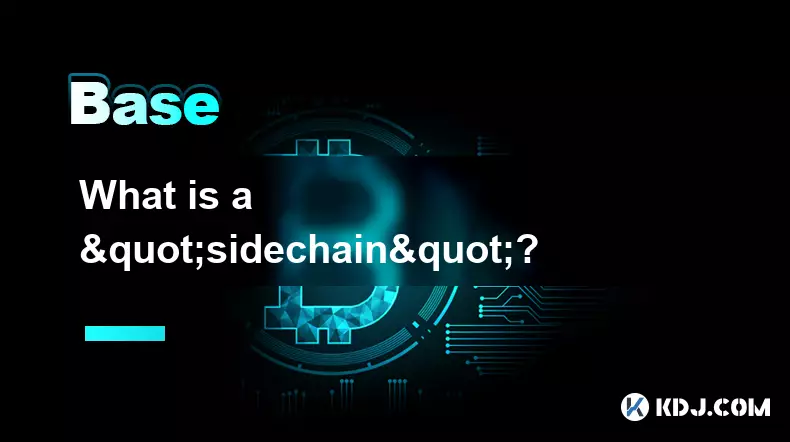-
 bitcoin
bitcoin $115692.075601 USD
5.13% -
 ethereum
ethereum $4162.931611 USD
11.68% -
 bnb
bnb $1310.063287 USD
17.56% -
 tether
tether $1.000983 USD
0.00% -
 xrp
xrp $2.534505 USD
8.16% -
 solana
solana $198.235737 USD
13.49% -
 usd-coin
usd-coin $1.000236 USD
0.02% -
 dogecoin
dogecoin $0.207352 USD
12.89% -
 tron
tron $0.323043 USD
3.62% -
 cardano
cardano $0.701559 USD
11.88% -
 hyperliquid
hyperliquid $39.924597 USD
8.30% -
 chainlink
chainlink $18.934457 USD
11.56% -
 ethena-usde
ethena-usde $1.000552 USD
0.02% -
 stellar
stellar $0.340575 USD
7.05% -
 bitcoin-cash
bitcoin-cash $545.011757 USD
8.86%
What are gas fees on the Ethereum network?
Gas fees on Ethereum compensate for computational work, with costs varying based on network demand, transaction complexity, and priority fees.
Oct 13, 2025 at 09:36 am

Understanding Gas Fees in Ethereum Transactions
1. Gas fees are payments made by users to compensate for the computational energy required to process and validate transactions on the Ethereum blockchain. Every operation, from transferring ETH to executing smart contracts, consumes a certain amount of gas. This mechanism ensures that network resources are used efficiently and prevents spam.
2. The cost of gas is denominated in gwei, a subunit of ETH where 1 gwei equals 0.000000001 ETH. Users specify a gas price they are willing to pay per unit of gas, and this influences how quickly their transaction is picked up by miners or validators. Higher gas prices typically result in faster confirmations.
3. Gas fees consist of two components: the base fee and the priority fee. The base fee is dynamically adjusted based on network congestion and is burned, removing it from circulation. The priority fee, also known as the tip, goes directly to validators and incentivizes them to include a transaction in the next block.
4. During periods of high demand—such as during NFT minting events or major DeFi launches—gas fees can spike dramatically. Users competing for limited block space drive up the price, sometimes making small transactions economically unviable.
5. EIP-1559, implemented in August 2021, reformed the gas fee structure by introducing a base fee that adjusts algorithmically and is burned, reducing long-term ETH supply inflation and making fee estimation more predictable for users.
Factors Influencing Gas Price Volatility
1. Network congestion plays a central role in determining gas prices. When many users interact with decentralized applications simultaneously, blocks become full, forcing users to bid higher to get priority.
2. Smart contract complexity affects gas consumption. A simple token transfer uses less gas than interacting with a multi-step yield farming protocol, which involves numerous calculations and state changes.
3. The transition from Proof-of-Work to Proof-of-Stake under the Ethereum Merge did not directly lower gas fees but improved network efficiency and laid the foundation for future scalability upgrades like shard chains.
4. External market conditions, including speculative trading surges and flash loan exploits, contribute to sudden spikes in transaction volume, further increasing competition for block space.
5. Wallet interfaces and dApps often provide gas estimators that analyze recent block data to suggest optimal pricing, helping users avoid overpaying or facing delays.
Strategies to Manage Ethereum Gas Costs
1. Timing transactions during off-peak hours—typically late at night UTC—can significantly reduce gas expenses, as fewer users are active on the network.
2. Using Layer 2 solutions such as Arbitrum, Optimism, or zkSync allows users to conduct transactions off-chain while inheriting Ethereum’s security, often reducing fees by over 90% compared to mainnet.
3. Setting custom gas limits and prices through advanced wallet settings gives experienced users greater control, though setting values too low may result in failed or stuck transactions.
4. Aggregators like MetaMask or tools like GasNow offer real-time gas tracking, enabling users to act when rates drop below certain thresholds.
5. Some decentralized exchanges and protocols now support batched transactions or native fee abstraction, allowing users to pay fees in alternative tokens or bundle operations to minimize overhead.
Frequently Asked Questions
What happens if I set my gas price too low?If the gas price is below the current market rate, miners or validators may ignore the transaction. It can remain pending indefinitely or eventually be dropped from the mempool, requiring resubmission with a higher fee.
Can gas fees be refunded?Only the unused portion of gas is refunded. For example, if you allocate 50,000 gas but only consume 30,000, the remaining 20,000 is returned. However, the gas consumed during execution—including for failed transactions—is non-refundable.
Why do some transactions fail even after paying gas?Transactions may fail due to incorrect parameters, insufficient balance for the intended action, or logic errors in smart contracts. Even failed transactions consume gas because computational work was performed.
Are gas fees the same across all Ethereum wallets?Yes, the underlying fee structure is consistent regardless of the wallet used. However, different wallets may estimate or suggest varying gas prices based on their own algorithms or user preferences.
Disclaimer:info@kdj.com
The information provided is not trading advice. kdj.com does not assume any responsibility for any investments made based on the information provided in this article. Cryptocurrencies are highly volatile and it is highly recommended that you invest with caution after thorough research!
If you believe that the content used on this website infringes your copyright, please contact us immediately (info@kdj.com) and we will delete it promptly.
- XRP Price Prediction: Weekend Rollercoaster or Rally?
- 2025-10-12 08:45:16
- Bittensor (TAO): Super Bullish Signals Point to Potential 2x Rally
- 2025-10-11 10:25:12
- Silver Price Correction: Navigating the Dip & Identifying Key SEO Keywords
- 2025-10-11 10:25:12
- Decoding Crypto Trends: Bittensor's Bull Run, Cardano's Dip, and LivLive's Presale Buzz in 'Uptober 2025'
- 2025-10-12 08:45:16
- MoonBull: The Crypto Meme Coin Promising 1000x Gains?
- 2025-10-11 10:30:01
- Crypto Payroll Revolution: Stablecoins, Altcoins, and the Future of Salary Payments
- 2025-10-11 10:30:01
Related knowledge

What does it mean for code to be "open source" in crypto?
Oct 12,2025 at 01:54pm
Understanding Open Source in the Cryptocurrency Ecosystem1. In the context of cryptocurrency, open source refers to software whose code is publicly ac...

What is the purpose of a "testnet"?
Oct 12,2025 at 09:01am
Understanding the Role of Testnets in Blockchain Development1. A testnet serves as a parallel version of a blockchain network, designed specifically f...

How to avoid phishing scams in crypto?
Oct 13,2025 at 06:18pm
Understanding Common Crypto Phishing Tactics1. Cybercriminals frequently use fake websites that mirror legitimate crypto exchanges or wallet platforms...

What is the difference between single-collateral and multi-collateral Dai?
Oct 12,2025 at 05:18pm
Understanding Single-Collateral Dai1. Single-Collateral Dai (SCD) was the original version of the Dai stablecoin launched by MakerDAO in 2017. It allo...

What is a "sidechain"?
Oct 13,2025 at 02:36pm
Understanding the Concept of Sidechains1. A sidechain is a blockchain that operates independently but is connected to another blockchain, known as the...

What is "EIP-1559" and how did it change Ethereum?
Oct 12,2025 at 03:00am
Understanding EIP-1559 and Its Core Mechanism1. EIP-1559 is a protocol upgrade introduced to the Ethereum blockchain as part of the London hard fork i...

What does it mean for code to be "open source" in crypto?
Oct 12,2025 at 01:54pm
Understanding Open Source in the Cryptocurrency Ecosystem1. In the context of cryptocurrency, open source refers to software whose code is publicly ac...

What is the purpose of a "testnet"?
Oct 12,2025 at 09:01am
Understanding the Role of Testnets in Blockchain Development1. A testnet serves as a parallel version of a blockchain network, designed specifically f...

How to avoid phishing scams in crypto?
Oct 13,2025 at 06:18pm
Understanding Common Crypto Phishing Tactics1. Cybercriminals frequently use fake websites that mirror legitimate crypto exchanges or wallet platforms...

What is the difference between single-collateral and multi-collateral Dai?
Oct 12,2025 at 05:18pm
Understanding Single-Collateral Dai1. Single-Collateral Dai (SCD) was the original version of the Dai stablecoin launched by MakerDAO in 2017. It allo...

What is a "sidechain"?
Oct 13,2025 at 02:36pm
Understanding the Concept of Sidechains1. A sidechain is a blockchain that operates independently but is connected to another blockchain, known as the...

What is "EIP-1559" and how did it change Ethereum?
Oct 12,2025 at 03:00am
Understanding EIP-1559 and Its Core Mechanism1. EIP-1559 is a protocol upgrade introduced to the Ethereum blockchain as part of the London hard fork i...
See all articles























![[4K 60fps] Anyway by Retropt (1 Coin) [4K 60fps] Anyway by Retropt (1 Coin)](/uploads/2025/10/13/cryptocurrencies-news/videos/k-fps-retropt-coin/68ec4f42a41d0_image_500_375.webp)


















































